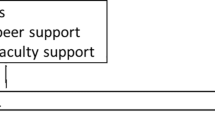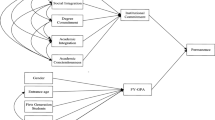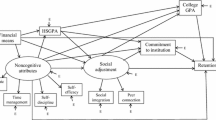Abstract
We studied the effects of academic performance, motivation, and social connectedness on third-year retention, transfer, and dropout behavior. To accommodate the three outcome categories and nesting of data within institutions, we fit a hierarchical multinomial logistic regression path model with first-year academic performance as a mediating effect. Our sample included 6,872 students representing 23 four-year universities and colleges. This work expands the current state of persistence research by (1) considering the effects of motivation and social connectedness on college persistence beyond the first year of college, (2) testing whether the effects of motivation and social connectedness on third-year retention and transfer are direct, indirect, or both, and (3) testing whether the effects of academic performance, motivation, and social connectedness are different for retention and transfer. We found that academic performance has large effects on likelihood of retention and transfer; academic self-discipline, pre-college academic performance, and pre-college educational development have indirect effects on retention and transfer; and college commitment and social connectedness have direct effects on retention. Academic self-discipline led to greater first-year academic performance, which suppressed its effect on retention and transfer. Practical and theoretical implications of these findings and directions for future research are discussed.
Similar content being viewed by others
References
ACT, Inc. (1997a). ACT assessment technical manual. Iowa City, IA: Author.
ACT, Inc. (1997b). Prediction research services summary tables. Iowa City, IA: Author.
ACT, Inc. (2005). Crisis at the core. Iowa City, IA: Author.
ACT, Inc. (2006). National collegiate retention and persistence to degree rates. Iowa City, IA: Author.
Agresti, A. (1990). Categorical data analysis. New York: Wiley.
Allen, J., Robbins, S., & Sawyer, R. (2008). Can measuring psychosocial factors promote college success? Manuscript submitted for publication.
Braxton, J., Sullivan, A., & Johnson, R. (1997). Appraising Tinto’s theory of college student departure. In J. C. Smart (Ed.) Higher education: Handbook of theory and research (Vol. 12, pp. 107–158). New York: Agathon.
Bridgeman, B., McCamley-Jenkins, L., & Ervin, N. (2000). Predictions of freshman grade point average from the revised and recentered SAT I: Reasoning test. College Board Research Report No. 2000-1. New York: College Entrance Examination Board.
Burd, S. (2004). Colleges permit too many needy students to drop out, says report on graduation rates. Chronicle of Higher Education, 50(39), A19.
Cabrera, A. F., Castaneda, M. B., Nora, A., & Hengstler, D. (1992). The convergence between two theories of college persistence. Journal of Higher Education, 63, 143–164.
Cabrera, A., Nora, A., & Castaneda, M. (1993). College persistence: Structural equations modeling test of an integrated model of student retention. Journal of Higher Education, 62, 123–139.
Carey, K. (2004). A matter of degrees: Improving graduation rates in four-year colleges and universities. Washington, DC: The Education Trust.
Cole, R. P., Saltonstall, M., & Gore, P. (2008). Assessing student readiness to promote student success: A campus collaboration. In W. Troxel & M. Cutright (Eds.), Exploring the evidence: Campus-wide initiatives in the first college year. Columbia, SC: The National Resource Center for the First-Year Experience and Students in Transition, University of South Carolina.
DesJardins, S., Ahlburg, D., & McCall, B. (2002). A temporal investigation of the factors related to timely degree completion. Journal of Higher Education, 73, 555–581.
DesJardins, S. L., Kim, D. O, & Rzonca, C. S. (2002–2003). A nested analysis of factors affecting bachelor’s degree completion. Journal College Student Retention, 4, 407–435.
Easterling, D., Pattern, J., & Krile, D. (1995). The impact of developmental education on student progress: A three-year longitudinal analysis. Paper presented at the meeting of the Association for Institutional Research, Boston.
Eccles, J. S., & Wigfield, A. (2002). Motivational beliefs, values, and goals. Annual Review of Psychology, 53, 109–132.
Fidler, P. (1999). The USC Freshman Seminar today: Twenty-five years of outcomes results. Paper presented at the 12th International Conference on the First-Year Experience, Edinburgh, Scotland.
Geweke, J. (1992). Evaluating the accuracy of sampling-based approaches to the calculation of posterior moments (with discussion). In J. M. Bernado, et al. (Eds.), Bayesian statistics 4 (pp. 169–193). Oxford: Oxford University Press.
Harackiewicz, J. M., Barron, K. E., Tauer, J. M., & Elliot, A. J. (2002). Predicting success in college: A longitudinal study of achievement goals and ability measures as predictors of interest and performance from freshman year through graduation. Journal of Educational Psychology, 94, 562–575.
Herzog, S. (2005). Measuring determinants of student return vs. dropout/stopout vs. transfer: A first-to-second year analysis of new freshmen. Research in Higher Education, 46, 883–928.
Johnson, V. E. (2003). Grade inflation: A crisis in college education. New York: Springer-Verlag.
Le, H., Casillas, A., Robbins, S., & Langley, R. (2005). Motivational and skills, social, and self-management predictors of college outcomes: Constructing the student readiness inventory. Educational and Psychological Measurement, 65, 482–508.
Liu, W. M., Ali, S. R., Soleck, G., Hopps, J., Dunston, K., & Pickett, T. (2004). Using social class in counseling psychology research. Journal of Counseling Psychology, 51, 3–18.
Mackinnon, D. P., & Dwyer, J. H. (1993). Estimating mediated effects in prevention studies. Evaluation Review, 17, 144–158.
Mackinnon, D. P., Krull, J. L., & Lockwood, C. M. (2000). Equivalence of the mediation, confounding and suppression effect. Prevention Science, 1, 173–181.
McGrath, M., & Braunstein, A. (1997). The prediction of freshmen attrition: An examination of the importance of certain demographic, academic, financial, and social factors. College Student Journal, 31, 396–408.
Mitchell, T. R., Holtom, B. C., Lee, T. W., Sablynski, C. J., & Erez, M. (2001). Why people stay: Using job embeddedness to predict voluntary turnover. Academy of Management Journal, 44, 1102–1122.
National Center for Supplemental Instruction. (1997). Supplemental Instruction (SI): Review of research concerning the effectiveness of SI from the University of Missouri-Kansas City and other institutions from across the United States. Kansas City: University of Missouri- Kansas City, Center for Academic Development.
Nora, A., & Carbrera, A. (1993). The construct validity of institutional commitment: A confirmatory factor analysis. Research in Higher Education, 34, 243–262.
Pascarella, E. T., & Terenzini, P. T. (2005). How college affects students: A third decade of research. San Francisco: Jossey-Bass.
Peterson, C. H., Casillas, A., & Robbins, S. B. (2006). The student readiness inventory and the big five: Examining social desirability and college academic performance. Personality and Individual Differences, 41, 663–673.
Porter, S. R. (2002). Including transfer-out behavior in retention models: Using the NSC EnrollmentSearch data. AIR Professional File, 82(Winter), 1–16.
Robbins, S., Allen, J., Casillas, A., Peterson, C., & Le, H. (2006). Unraveling the differential effects of motivational and skills, social, and self-management measures from traditional predictors of college outcomes. Journal of Educational Psychology, 98, 598–616.
Robbins, S., Lauver, K., Le, H., Davis, D., Langley, R., & Carlstrom, A. (2004). Do psychosocial and study skill factors predict college outcomes? A meta-analysis. Psychological Bulletin, 130, 261–288.
Seidman, A. (1991). The evaluation of a pre/post admissions/counseling process at a suburban community college: Impact on student satisfaction with the faculty and the institution, retention, and academic performance. College and University, 66, 223–232.
Selingo, J. (2001) Colleges and lawmakers push students to graduate in 4 years. Chronicle of Higher Education, 48(11), A22.
Spiegelhalter, D., Thomas, A., Best, N., & Lunn, D. (2003). WinBUGS user manual version 1.4, January 2003. Cambridge, UK: MRC Biostatistics Unit, Institute of Public Health.
Tinto, V. (1993). Leaving college: Rethinking the cause and cures of student attrition (2nd ed.). Chicago: University of Chicago.
Acknowledgment
Thanks to James Sconing for assistance with earlier versions of this manuscript.
Author information
Authors and Affiliations
Corresponding author
Additional information
A previous version of this paper was presented at the 2nd Annual National Symposium on Student Retention, Albuquerque, New Mexico, October 2006.
Rights and permissions
About this article
Cite this article
Allen, J., Robbins, S.B., Casillas, A. et al. Third-year College Retention and Transfer: Effects of Academic Performance, Motivation, and Social Connectedness. Res High Educ 49, 647–664 (2008). https://doi.org/10.1007/s11162-008-9098-3
Received:
Published:
Issue Date:
DOI: https://doi.org/10.1007/s11162-008-9098-3




